Redefining athletic performance through virtual online sports experiences marks a revolutionary shift in how athletes train, compete, and engage with their sport. Traditionally, athletic performance has been confined to physical venues such as stadiums, gyms, and training facilities, where in-person coaching, direct competition and real-time feedback have been the norm. However, the rise of advanced digital technologies and virtual platforms is transforming these conventional boundaries, offering athletes new ways to optimize performance, increase accessibility, and connect globally. Virtual online sports experiences leverage interactive simulations, real-time analytics, and immersive environments to create dynamic training and competition scenarios that were once unimaginable. One of the key ways virtual sports experiences redefine athletic performance is through enhanced data-driven training. Using sensors, wearable devices, and motion capture technology integrated with online platforms, athletes can now receive instant, precise feedback on their biomechanics, technique, and physiological responses. This continuous flow of information allows for more targeted improvements and fine-tuning of skills, reducing injury risk and maximizing efficiency.

Unlike traditional coaching, which can be limited by time and location, virtual training enables athletes to track their progress in real-time and adjust their routines accordingly, fostering a more scientific and personalized approach to athletic development. Moreover, virtual online sports experiences break down geographical barriers, creating opportunities for athletes to compete and collaborate across the globe. Virtual competitions, leagues, and tournaments allow participants to test their abilities against diverse opponents without the need for travel, saving time and resources. This global connectivity not only raises the level of competition but also exposes athletes to different styles and strategies, broadening their understanding of their sport. The ability to engage in high-level competition virtually encourages consistent participation and pushes athletes to maintain peak performance throughout the year, rather than only during specific seasons or events. Immersive virtual reality VR environments can simulate high-pressure situations, helping athletes develop mental resilience and focus.
Training in these controlled yet challenging scenarios equips athletes to handle real-world competition stress more effectively. Additionally, virtual experiences often incorporate gamification elements, such as rewards and leaderboards, which enhance motivation and engagement, making training both enjoyable and mentally stimulating. This combination of physical and psychological conditioning is crucial for holistic athletic development. Virtual sports also democratize access to elite training resources. Aspiring athletes from remote or underserved regions can connect with top coaches, trainers, and sports scientists through online tarung toto platforms. This increased accessibility helps level the playing field, allowing talent to flourish regardless of socioeconomic or geographic limitations. By fostering inclusivity, virtual sports experiences contribute to a more diverse and competitive athletic community. This new paradigm offers athletes personalized, data-driven, and immersive tools to elevate their abilities while promoting mental toughness and inclusivity. As these virtual platforms continue to evolve, they will undoubtedly play a pivotal role in defining the future of sports performance and competition worldwide.
